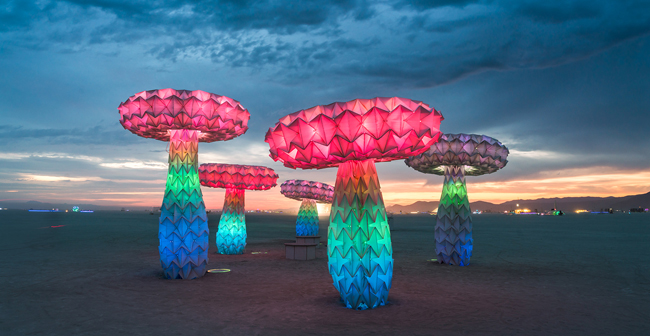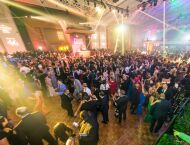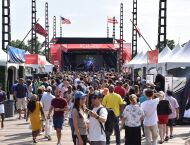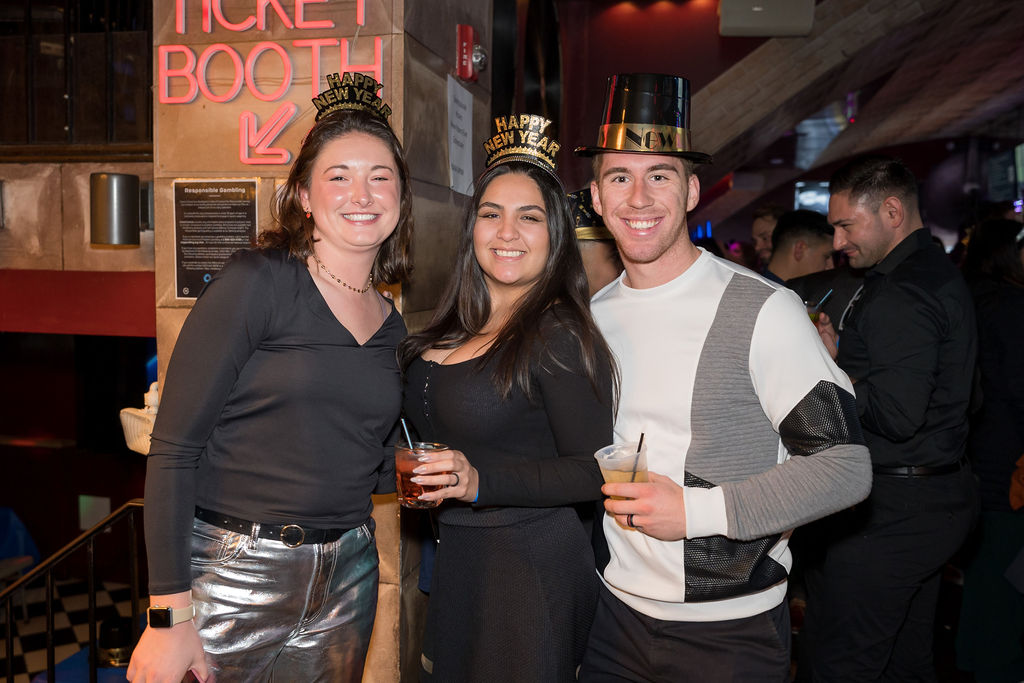Culture
 Photo: Courtesy of FoldHaus
Photo: Courtesy of FoldHaus
No Spectators: The Art of Burning Man at the Renwick
April 10, 2018 @ 12:00am
There’s a temple at Renwick today, but unlike the National Shrine or the National Cathedral, it sneaks up on you. You won’t see David Best’s monumental architecture coming until you’ve walked into it. Best, an American sculptor, has been making temples for Burning Man on and off since 2000, and his latest work is an installation for No Spectators: the Art of Burning Man, on view now in and around the Renwick Gallery.
He’s one of the many stalwarts represented in the exhibition at Black Rock City, the temporary city erected each year in the Nevada desert for the festival. Sculptures include Andre the Giant-sized LED-lit mushrooms and even an incarnation of the “Man” i.e., the one burned at the end of annual festival, and that makes me think of Wicker Man, starring Nicolas Cage.
Best’s installation is impossibly intricate. It’s installed upstairs, in the main gallery space, known as the “Grand Salon,” which recently housed the Parallax Gap installation. Parallax, I found, was somewhat underwhelming. It looked good in photos but failed to land in person. Best’s temple has the opposite effect.
Best is among what Kim Cook, a Burning Man ambassador and partner in the exhibition, refers to as one of the “greats” of the iconic festival, many of whom were actually present at the preview. Some were in full “burner” regalia and it felt like Night at the Museum.
(Side note, there’s a lot of lingo for this exhibition. Already I’ve used “burner,” Black Rock City, I’m about to use “Playa” and “Cacophony Society,” and, of course, the “Man.” For a full glossary click here. You can find the “Man” under “Man, the.”)
You can also find the “Cacophony Society” in the glossary. This is the “randomly gathered network of individuals united in the pursuit of experience beyond the mainstream” from which the festival sprang. Their history and the history of the festival, from its San Francisco beach origins to the Playa, i.e. the Black Rock desert, is detailed in the adjacent gallery.
The must-see pieces include the “Shrumen Lumen” from FoldHaus collective, which is also upstairs. Another is the massive arch downstairs that recalls a Brothers Quay film and the “Gamelatron,” which is directly opposite the Grand Salon upstairs. There’s also a VR experience downstairs, a “tin pan dragon,” that the artist insisted would eat me, and several sculptures installed on the streets around the Renwick.
Aaron Taylor Kuffner’s “Gamelatron” though is the one I can’t wait to return to. The piece is a fully robotic gamelan orchestra that’s attached to the walls and so surrounds the listener standing in the middle of the room. If you’re unfamiliar with Gamelan music, imagine an orchestra of pitched percussion with a variety of gongs. It’s a piece that makes you believe, though I couldn’t say in what.
Kuffner’s piece along with some of the aforementioned brought me to believe in the exhibition, so to speak. Before seeing it myself, I was skeptical because Burning Man’s no longer cool and an art of Burning Man exhibition feels like a play for foot-traffic from people unaware that burners are the face of memes, not interest. Even Quiznos had some fun at the festival’s expense. Or check out Thump’s tremendous listicle on the types of people who will ruin Burning Man.
However, that’s all noise and not art. Even my one experience with a burner is noise. (He was a douche who talked at people about his “burn” and no one gave a fuck.) Some of the pieces are pretty damn cool, I’m looking forward to spending more time with it because fortunately the Renwick is free. No Spectators: the Art of Burning Man is on view through January 21, 2019. Check out the Renwick’s behind-the-scenes YouTube playlist as well.
Renwick Gallery of the Smithsonian American Art Museum: 1661 Pennsylvania Ave. NW, DC; 202-633-7970; www.americanart.si.edu/visit/renwick








